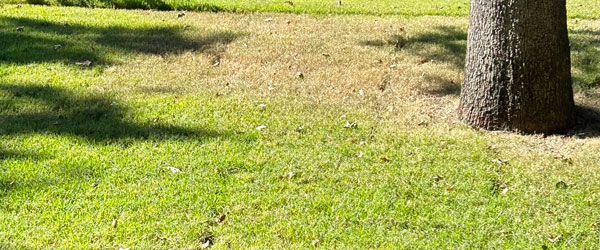Q&A – Ask Neil: October 31, 2024
(Please read these instructions carefully.)
Before you post your question, please look at recent issues to see if someone else has already asked it. You might find your answer there.
How to submit your question…
(Note: You may need to allow a pop-up window to come up in order to get the link for sending your photo(s). If you have already submitted your question and didn’t see the pop-up window, please click here.)
• Click the link provided below to post your question. After you submit your question, a new window will pop up giving you the address to which you can e-mail a SHARP, HIGH-RESOLUTION PHOTO to accompany your question. Please DO NOT SEND THUMBNAIL PHOTOS in case I need to zoom in to see things.
• Click here to post your question.
• Please ONLY POST YOUR QUESTION ONE TIME. We can only accept a set number of questions each week, and when we get duplicates it costs other people their chances.
• One question per reader, please.
• Please use this only for posting questions – not for standard emails.
• Watch for your answer in the following week’s e-gardens.
• I choose those of greatest general interest. For example, plant IDs seldom make the cut.
• I must have your first name or initials.
• I must have your city or county. (Texas is a very large state.)
QUESTION 1
DO WE REALLY NEED THE BAMBOO STAKES?
Question: We bought a crape myrtle from a tree farm. They planted it with three stakes. Bamboo stakes were strapped to the main stems with Velcro. They were tight, so I loosened them. Since it’s already staked, do we need the bamboo? Cathy O., Springtown.

Answer: At the risk of sounding coarse, I don’t see any stakes worth leaving. The bamboo stakes are brittle and wouldn’t hold the crape myrtle stems against 20 mph breezes. I can’t tell for certain if there are metal stakes. If so, they appear to be too short. The fabric ties are too low on the body of the crape myrtle to do much good. Honestly, the trunks of the crape myrtle will thicken up better and faster if you’ll take all the staking materials away. It appears that the main trunks (probably three) are thick enough to stand on their own. It’s likely time to trim off all those basal shoots in the bottom 15-18 inches of the stems. You could do all of that now.
QUESTION 2
WHAT SHOULD WE DO WITH THIS POST OAK?
Question: We have unusually large post oaks surrounding our home. One of the 3 trees has an odd oval fungus about 12 ft. up the tree at a joint where a limb was cut years ago. How should we treat this situation, and is our tree in danger? Jennifer J., Abilene.
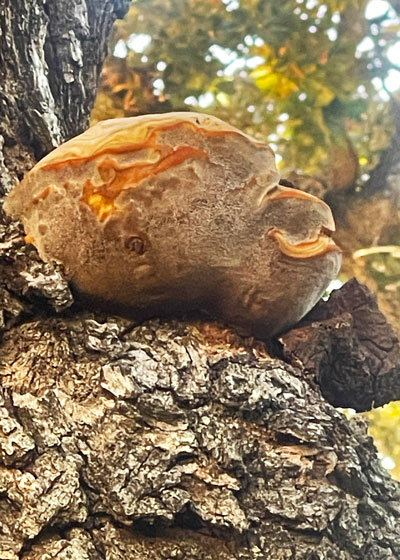
Answer: This appears to be a fungal conk similar to the ones on the reader’s oaks in last week’s Q&A. Look your tree over very critically for any evidence of decay. Look for other conks up and down the trunk and any that might be originating from the roots. Above all, have a certified arborist look at the tree as soon as you can and perhaps even have the growth cultured through the Texas A&M Plant Disease Clinic to see if it is something that is likely to spread via root grafts or mechanical injuries to adjacent oaks. My fear is that this tree, like the one in last week’s Q&A, is in great jeopardy.
QUESTION 3
SEE THE GOOD EFFECTS OF PRUNING TWO NANDINAS
Question: In January or February 2023, you had a story on pruning nandinas. This year I pruned two of the plants in this bed, and here is a photo from just 6 months later. You are welcome to use this photo to illustrate how well it works. Louise S., Decatur.

Answer: What a wonderful comparison. Louise is referring to our recommendation of cutting the tallest 50 percent of the canes completely back to the ground each winter. That keeps the plant more compact because new sprouts will emerge from the bases and fill in where otherwise bare stems would have been. The next year you repeat the process, for the most part cutting the canes that you left in place the previous year. Look at how lush and vigorous the new growth on those two plants on the left is.
QUESTION 4
WHY DOES MY ZORRO ZOYSIA CONSISTENTLY LOOK DRY?
Question: Our Zorro zoysia was planted in April of this year. Why does it have this brown area? We water it 3 times per week for 7 minutes per station, so I don’t believe we are overwatering it. Please help. Moncy N., Grapevine.
Answer: It looks very dry. I can also see seams where the pieces of sod were originally. It’s entirely possible that these pieces were allowed to get too dry after they were planted, or they might have been on the outside of the stack of sod. Watering for only 7 minutes essentially every other day was probably not enough to encourage deep rooting into the soil. It made it through the very wet late spring just fine, but when the hot, dry summer weather arrived your grass didn’t have any reserve power to carry it through. Once it’s established, your goal should be to soak it to a depth of several inches, then to be able to go 3 or 4 days before having to water again.
QUESTION 5
HOW CAN I GET RID OF THIS CLOVER?
Question: Our garden has been overgrown by clover. It has reddish color to its stems and roots. Digging it up and removing the roots has not proven successful. It keeps coming back. What can we do? William H., Dallas.
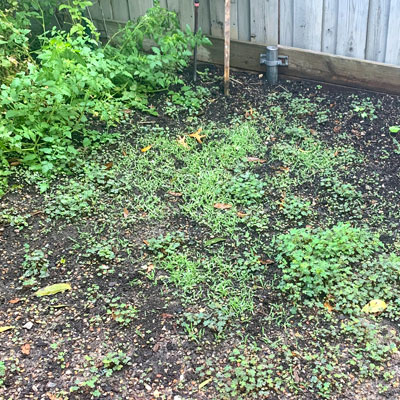
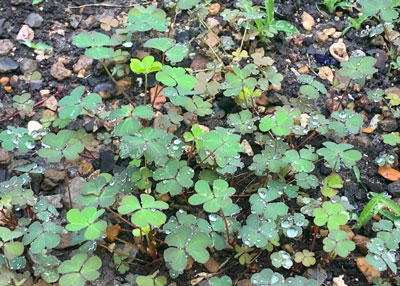
Answer: Lovely photo of a noxious weed called sheep sorrel, or oxalis. It’s not a clover, but instead a sister to the popular pink-flowering border perennial with which you’re probably familiar.
The problem in controlling your weed is that its leaves are quite waxy. Weedkiller sprays bead up and roll off. Your photo illustrates that perfectly.
Use a broadleafed weedkiller containing 2,4-D while the garden is empty of vegetable plants. Include one drop of a liquid dishwashing detergent per gallon of mixed spray. Use a pump-type tank sprayer adjusted so that it will put out very fine droplets, just short of being a mist. Coat the leaves almost to the point of runoff. Repeat 7 days later. Mulching your garden with shredded fallen tree leaves or well-rotted compost will also help prevent germination of the seeds.
QUESTION 6
WHAT IS WRONG WITH OUR BERMUDA?
Question: We have a 29-year-old bermuda lawn that has given us trouble since we bought our property four years ago. It’s a 1-acre lot watered by rotary sprinklers. We are restricted to twice weekly watering, but I don’t think this is the problem. Could this be a fungus? Rob L., McKinney.
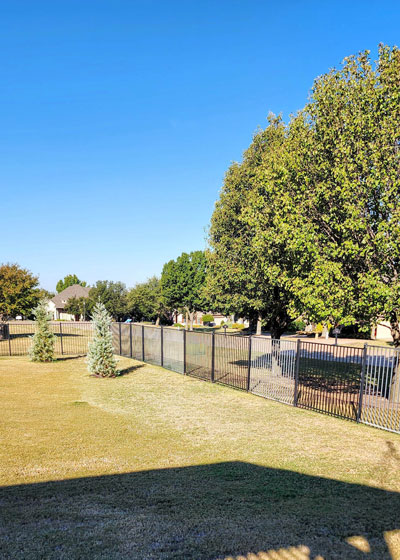
Answer: This is not a fungus. This grass is so uniformly brown that it almost looks like it was recently scalped, perhaps for overseeding?? (I’m also judging because it is cut so short as we would do to overseed.) I live in McKinney also, and I also have a large amount of bermuda. It can be maintained quite well with twice-weekly watering, but only if the sprinklers are allowed to run long enough in each location to soak the soil 4 to 6 inches deep. A total of 21 minutes per week would not be enough. That should translate to applying 1-1/2 in. per week. The trees in your photo also look very dry. I’m guessing that one month with very high temperatures and absolutely no rain has taken a toll on your lawn and the neighborhood landscape. I drive probably 15 or 20 miles daily through our city, and almost every block looks like yours. Let’s adjourn our worries until we’ve had some rains. I’ll bet your lawn will look a lot better.
QUESTION 7
HOW CAN I PRUNE MY PITTOSPORUM BACK TO THEIR NATURAL SHAPE?
Question: I planted my pittosporum hedge after the big February freeze of 2021. Since then it has fought more freezes, hungry deer, drought, and now water rationing. How can I prune them back to their natural shape? Claudia C., Corpus Christi.
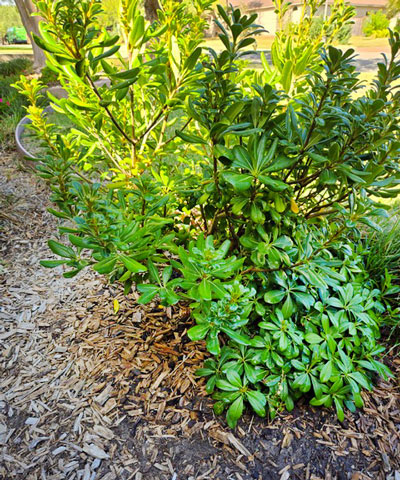
Answer: You will have to do so with lopping shears and hand pruning shears. You’ll notice that each branch grows whorls of new shoots. One of those shoots will become dominant and elongated, and that will be the one you will have to remove. It must be done one branch at a time. You must not prune pittosporums with hedge trimmers.

